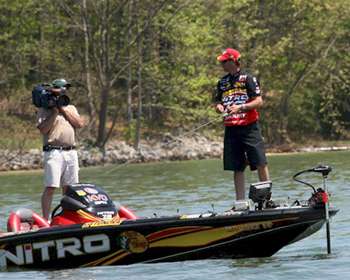
It's a well-known fact that hook selection is a critical part of success on the water. Not only does the right hook increase the number of fish you put in the boat, it can also increase the number of bites that you get.
With six Toyota Tundra Bassmaster Angler of the Year titles, Michigan's Kevin VanDam has hooked and landed more than his fair share of bass throughout the course of his professional career. Over the past several years, he has worked closely with his hook sponsor, Mustad, to develop and improve the rigging techniques and hooking ratio of bass hooks.
"A lot of people ask me what hook I like to use with different baits," says VanDam. "We have so many hooks now, and the technology has come so far in the hook design and the quality of the points, that you can't just use one hook for all the different baits." For VanDam, his hook selection revolves around three basic components — hook gap, rigging ease and wire diameter.
"I like to probably go a size bigger than most people do," says VanDam. "I know that when the fish bites, I want to have plenty of gap there to hook the fish." With a wide gap between the hook point and the shank of the hook, the soft plastic bait has plenty of room to collapse against the shank of the hook, rather than impede with the hooking power.
Along with a big gap, VanDam also stresses the importance of using a hook that allows the bait to be properly rigged and fished. He's excited about the recent introduction of Mustad's new KVD Grip-Pin hook, which features a welded keeper lock just below the bend on the eye of the hook.
"The keeper lock really makes a big difference," he says. "When I'm using a flipping bait like a 3-inch Strike King Rodent, it can be really hard to rig correctly. With the keeper, the bait is locked in place and can't slide down the shank of the hook. That's really important because if the bait balls up on the shank of the hook, it could keep you from getting the hook in the bass."
With the recent popularity in soft plastic swimbaits like the Strike King Shadalicious, VanDam says that gap and rigging are paramount to success. "For swimbaits, you really need to use a wide gap hook," he says. "I like the Mustad Power Lock Plus that features a screw-in head with a centering pin. It holds the bait in place so that the bait won't ball up when you set the hook.
The main thing is that the right hook will help you catch more bass." When using a standard wide gap hook with minnow baits like a Strike King Caffeine Shad, VanDam favors a Mustad Z-Lock hook. Featuring a "Z" shaped bend in the neck instead of a standard 90-degree bend, the Z-Lock allows the bait to perform naturally in the water. "If you just use a standard 90-degree offset hook, the bait is still going to slide off the hook. With a Z-Lock, the bait will be locked into place," he claims.
Finally, VanDam pays attention to the wire diameter of his hook. "I want a hook with the correct wire diameter so the hook isn't going to flex," he stresses. "If I'm throwing 10-pound-test line, I'm going to us a light-wire version. If I'm throwing 17- or 20-pound-test line, I'm going to use the heavy-wire version. "Always look at the hook diameter and the gap," says VanDam "The smaller and thinner the bait, the smaller hook you can get way with. I don't like to cheat down in size though."
(Provided by Z3 Media)




